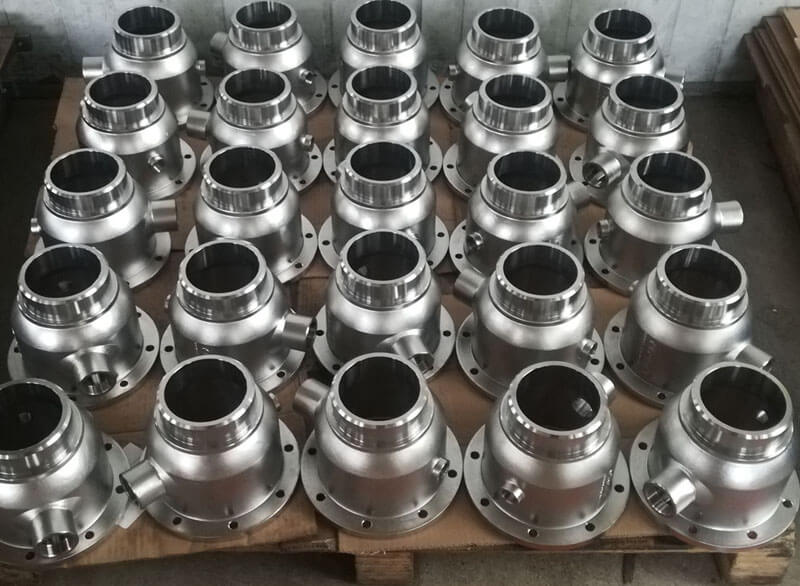Customized Valve Casting Parts: A Comprehensive Guide
Customized valve casting parts are an essential component in various industries, from automotive to aerospace. These parts are manufactured to meet specific requirements and can be customized to fit the needs of the client. Valve casting parts are used in various applications, including pumps, valves, and other industrial machinery.
Customized valve casting parts are made from a range of materials, including aluminum, magnesium, zinc, and copper. The manufacturing process involves using a mold to create the desired shape, which is then filled with molten metal. The metal cools, and the mold is removed, leaving a solid metal part. This process allows for intricate, complex designs to be created, making valve casting parts a popular choice for industries that require high precision and accuracy.
The demand for customized valve casting parts has increased over the years, with more industries relying on these parts for their machinery. This has led to the development of new techniques and technologies to improve the manufacturing process, resulting in parts that are stronger, more durable, and more precise than ever before. As the need for customized valve casting parts continues to grow, it is essential for manufacturers to keep up with the latest advancements in the industry to meet the demands of their clients.
Benefits of Customized Valve Casting Parts
Customized valve casting parts offer several benefits over traditional mass-produced stock items. Here are some of the key benefits:
1. Greater Design Flexibility
One of the biggest benefits of customized valve casting parts is the greater design flexibility they offer. With customized parts, manufacturers can create valves with complex shapes, patterns, and sizes, making them more adaptable to specific applications. This is especially useful in situations where off-the-shelf products do not meet the required specifications.
2. Higher Quality and Precision
Customized valve casting parts are produced using investment casting, a process that ensures high-quality and precision. Investment casting produces parts with tight tolerances, smooth surfaces, and excellent dimensional accuracy. This results in valves that are more reliable, durable, and efficient.
3. Faster Production and Shorter Lead Times
Investment casting also reduces labor time and shortens lead times because it greatly reduces the amount of machining required after the valve casting is cast. This means that customized valve casting parts can be produced faster and more efficiently, reducing production costs and increasing productivity.
4. Cost-Effective Solution
Customized valve casting parts are a cost-effective solution for many companies. With investment casting, manufacturers can create valves with different shapes, sizes, and patterns, making them customizable. This cuts down on human capital and machining costs as opposed to forging. In addition, customized valve casting parts are easily repairable and replaceable, making them a more cost-effective solution in the long run.
In summary, customized valve casting parts offer several benefits over traditional mass-produced stock items. They offer greater design flexibility, higher quality and precision, faster production and shorter lead times, and a cost-effective solution for many companies.

Factors to Consider When Choosing Customized Valve Casting Parts
When it comes to choosing customized valve casting parts, there are several factors that need to be taken into consideration. These factors can help ensure that the selected parts meet the specific needs and requirements of the application.
Material
One of the most important factors to consider when choosing customized valve casting parts is the material used in their construction. The material used can have a significant impact on the performance and durability of the parts. Some common materials used in valve casting include brass, bronze, stainless steel, and cast iron. Each material has its own unique properties, such as resistance to corrosion, strength, and thermal conductivity. It is important to choose the material that best suits the specific needs of the application.
Design
Another important factor to consider when choosing customized valve casting parts is the design of the parts. The design can impact the overall performance of the valve and how it operates. Some important design considerations include the size and shape of the valve, the number of ports, and the type of connection used. It is important to choose a design that is optimized for the specific application and can provide the required performance.
Manufacturing Process
The manufacturing process used to produce the customized valve casting parts is also an important consideration. There are several different manufacturing processes that can be used, including sand casting, investment casting, and die casting. Each process has its own unique advantages and disadvantages, such as cost, production time, and quality. It is important to choose a manufacturing process that can produce high-quality parts while meeting the specific requirements of the application.
Cost
Finally, the cost of the customized valve casting parts is also an important factor to consider. The cost can vary depending on the material used, the design of the parts, and the manufacturing process used. It is important to choose customized valve casting parts that provide the required performance while also being cost-effective.
In conclusion, choosing customized valve casting parts requires careful consideration of several factors, including the material used, the design of the parts, the manufacturing process, and the cost. By taking these factors into account, it is possible to select parts that meet the specific needs and requirements of the application.
Types of Customized Valve Casting Parts
Customized valve casting parts are metal parts produced by a casting process for assembling a valve. There are several types of customized valve casting parts, including:
Gate Valves
Gate valves are designed to control the flow of liquids and gases. They are commonly used in industrial applications, such as oil and gas production, chemical processing, and water treatment. Customized gate valve casting parts are made from a variety of materials, including carbon steel, stainless steel, and cast iron.
Globe Valves
Globe valves are designed to regulate the flow of liquids and gases. They are commonly used in applications where precise control of flow is required, such as in the pharmaceutical and food industries. Customized globe valve casting parts are made from a variety of materials, including stainless steel, bronze, and cast iron.
Ball Valves
Ball valves are designed to control the flow of liquids and gases. They are commonly used in industrial applications, such as oil and gas production, chemical processing, and water treatment. Customized ball valve casting parts are made from a variety of materials, including stainless steel, brass, and cast iron.
Check Valves
Check valves are designed to prevent backflow in a pipeline. They are commonly used in applications where the flow of liquids or gases must be restricted to one direction, such as in the oil and gas industry. Customized check valve casting parts are made from a variety of materials, including stainless steel, bronze, and cast iron.
In conclusion, customized valve casting parts are essential components of valves used in various industrial applications. The types of customized valve casting parts include gate valves, globe valves, ball valves, and check valves. These parts are made from a variety of materials, including carbon steel, stainless steel, brass, and cast iron.
Materials Used in Customized Valve Casting Parts
Customized valve casting parts are used in a variety of industries, including chemical, petrochemical, paper, mining, electric power, food, pharmaceutical, and more. These parts are used to control the flow of fluids and gases, and they must be made from materials that can withstand high temperatures, pressures, and corrosive environments.
The materials used in customized valve casting parts can vary depending on the specific application, but some common materials include:
- Stainless Steel: Stainless steel is a popular choice for valve casting parts because it is corrosion-resistant and can withstand high temperatures and pressures. Different grades of stainless steel can be used depending on the specific application.
- Carbon Steel: Carbon steel is another popular material for valve casting parts. It is strong, durable, and can withstand high temperatures and pressures. However, it is not as corrosion-resistant as stainless steel.
- Aluminum: Aluminum is a lightweight material that is often used in valve casting parts for its corrosion resistance and thermal conductivity. It is not as strong as steel, but it is a good choice for applications where weight is a concern.
- Bronze: Bronze is a copper alloy that is often used in valve casting parts for its corrosion resistance and low friction. It is a good choice for applications where the valve must operate smoothly and quietly.
Other materials that may be used in customized valve casting parts include brass, titanium, and nickel alloys. The choice of material will depend on the specific application and the requirements of the valve.
In addition to the material used, the casting process itself is also important. Different casting processes, such as sand casting and investment casting, can produce parts with different properties and characteristics. The choice of casting process will depend on factors such as the complexity of the part, the desired surface finish, and the quantity of parts needed.
Overall, the materials used in customized valve casting parts must be carefully chosen to ensure that the valve will perform reliably in its intended application.
Customized Valve Casting Parts Manufacturing Process
Customized valve casting parts are made using a variety of manufacturing processes, including shell mold casting and investment casting. The manufacturing process used depends on the desired characteristics of the valve, such as its size, shape, and material composition.
Shell mold casting is a manufacturing process that involves creating a mold of the valve body using a mixture of sand and resin. The mold is then filled with molten metal, which solidifies as it cools. This process is ideal for producing large quantities of valves quickly and efficiently, as it allows for the production of complex shapes with high accuracy and repeatability.
Investment casting, also known as lost-wax casting, is a manufacturing process that involves creating a wax model of the valve body and coating it with a ceramic shell. The shell is then heated, causing the wax to melt and flow out of the shell. Molten metal is then poured into the shell, filling the void left by the melted wax. This process is ideal for producing small quantities of valves with intricate shapes and tight tolerances.
After the valve body has been cast, it undergoes a series of finishing processes to achieve the desired surface finish and dimensional accuracy. These processes may include machining, grinding, polishing, and coating.
Customized valve casting parts can be made from a variety of materials, including steel, iron, and aluminum. The choice of material depends on the intended application of the valve, as well as factors such as cost, strength, and corrosion resistance.
Overall, the manufacturing process for customized valve casting parts is a complex and highly specialized process that requires a skilled workforce and advanced equipment. By utilizing the latest manufacturing technologies and techniques, manufacturers can produce high-quality valve-casting parts that meet the diverse needs of their customers.
